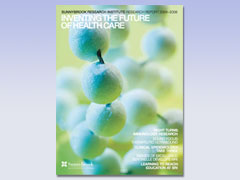There's Art in This Science
As a future researcher at New York's Memorial Sloan-Kettering Cancer Center with a PhD behind her, Maria Ciofani doesn't expect interactions with Dr. Juan Carlos Zúñiga-Pflücker—which might include collaboration and competition—will feel any different from those they enjoyed when she was his student. That's because, she says, "He treats us as individuals with important ideas." Interacting with students, postdoctoral fellows and technicians as collaborators is at the core of Zúñiga-Pflücker's management of the lab. As for the science, Ciofani says, "He'll never tell you not to do an experiment."
Indeed, Zúñiga-Pflücker has a certain fondness for failed experiments, from which he believes there's much to be learned. But, he says, "A badly conceived experiment doesn't teach you anything. We try to avoid that."
While achieving that artful equilibrium with lab members across multiple projects is the goal, getting to the start of that process can be daunting. When Zúñiga-Pflücker arrived at the University of Toronto in 1994, he was given a big lab space, into which he walked and found nothing but a few benches. No equipment, no staff, no instructions. "Nobody tells you what to expect," he says. "They don't take you aside and say, ‘This is how you run a lab.'" And that's how it has been done for decades, until recently. The National Institutes of Health in the U.S. now offers some postdocs training on starting and running a lab, and U of T is instituting a similar program. While Zúñiga-Pflücker believes this may help, he thinks it important that scientists develop their own opinions on running a lab, based on observing what different mentors did especially well. That approach also helps with the biggest change: moving from mentored to mentor.
"To become the mentor and do science by proxy is very different," says Zúñiga-Pflücker. "It can be difficult to let go and have an experiment done by someone else." Ciofani thinks Zúñiga-Pflücker still feels torn not being in the lab more, but that it's a natural progression that has allowed him to broaden his research. A constant temptation for an established scientist is to micromanage or impose a direction. But Zúñiga-Pflücker doesn't, and will get excited about ideas that aren't his. Renée de Pooter, another senior PhD student in the lab, says, "He's very supportive and hands-off, even if he doesn't agree with your hypothesis. I admire that." At the same time, he is not at all shy about expressing dislike, even disgust, for a poorly done experiment. "He can be very direct, and I like that," says Ciofani.
Zúñiga-Pflücker is less inclined toward blunt criticism now than early in his career, and he has refined his approach to choosing lab members. Students that have come from labs where their work wasn't necessarily going well are often more focused and better attuned to what research they want to pursue than someone successful from the start. They tend to fit well with Zúñiga-Pflücker's flexible style.
They also need to fit with the mix of personalities, skills and experience of existing lab members, and managing that mix is yet another challenge of running a lab, especially one focused mostly on T cell development. Though each lab member works on a specific part of T cell development, there is still movement within the projects. "We can think freely without stepping on someone's feet," says Ciofani. They have occasional clashes; Zúñiga-Pflücker keeps a lid on them by refusing to get involved—an approach that goes against the prevailing wisdom in many labs. "There's really no one answer for getting the right mix," says Zúñiga-Pflücker. "All the elements have to be there to make it happen, but it's like writing a good story—really hard to pin down. Happenstance, serendipity, coincidence, but all require a love of science."
PDF / View full media release »


